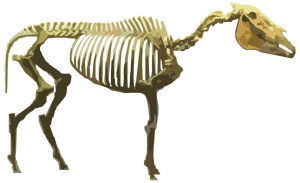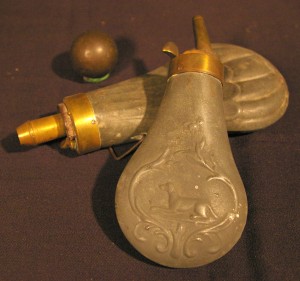PRE-HISTORY
The museum has a fully formed replica of the 3M-year-old Hagerman Horse, as well as other fossils and information about the Pleistocene era in the Hagerman Valley. We also has a large collection of photographs of the Thousand Springs, other springs, and major Snake River waterfalls before the development of electrical power in the Valley.
In the approximately 50 river miles between Twin Falls and King Hill, the Snake River plunges a thousand feet in elevation. As it descends, the river’s canyon is an exhibit of Pliocene and Pleistocene volcanic activity. Along the south side of the river, in the 3.5 million year-old lake beds, is the Hagerman Fossil Beds National Monument, internationally known as one of the richest late Pliocene faunas in the world.

 As the Snake River eroded its canyons, it cut through the Snake River Plain aquifer, exposing the water pooled between lava flows as a remarkable series of springs. The most famous was the Thousand Springs which stretched for hundreds of yards as it cascaded down the northern canyon wall.
As the Snake River eroded its canyons, it cut through the Snake River Plain aquifer, exposing the water pooled between lava flows as a remarkable series of springs. The most famous was the Thousand Springs which stretched for hundreds of yards as it cascaded down the northern canyon wall.
The catastrophic Bonneville Flood thundered through the valley 12-15,000 years ago, leaving enormous moraine-like fields of lava ‘Melon Boulders’ – some as big as cars – which were stripped from the canyon walls and tumbled for miles downstream. There are large fields of ‘Melon Boulders’ that can be seen in the countryside surrounding the City of Hagerman.
NATIVE PEOPLES
Come in and see our extensive arrowhead collections of tribes in the Hagerman Valley. We also have an important exhibit from the Crutchfield Garden Site in the City of Hagerman that yielded native American artifacts dating back over 7000 years. The museum has photographs of sturgeon caught in the Snake River that are of astounding size.
 The Hagerman Valley has a vibrant and exciting history because of the natural resources which drew both Indians and settlers. The Valley was the terminus of salmon and steelhead migrations from the Columbia River, and it supported Indian ‘tribes’ who resided in the valley or came to Lower or Upper Salmon Falls to fish. Some of the largest sturgeons on record were caught here, and these ancient fish still inhabit the river today.
The Hagerman Valley has a vibrant and exciting history because of the natural resources which drew both Indians and settlers. The Valley was the terminus of salmon and steelhead migrations from the Columbia River, and it supported Indian ‘tribes’ who resided in the valley or came to Lower or Upper Salmon Falls to fish. Some of the largest sturgeons on record were caught here, and these ancient fish still inhabit the river today.
EXPLORERS AND ADVENTURERS
Come in and view a large lithograph map of Fremont’s 1845 expedition, one of only five copies known to exist. Additionally, the museum has a copy of Fremont’s published diary of the expedition. A number of artifacts cast off by immigrant travelers along the Oregon Trail can be found in the museum’s collection

 Wilson Price Hunt and Ramsey Crooks were the first white men known to visit the area. They explored the valley in 1811 as members of the Astor Expedition. After 1816, during the heyday of the beaver trapping era, the valley was crisscrossed by hundred of trappers and mountain men. They were followed by missionaries traveling to the Oregon country in the 1830s. Major military–led expeditions by Bonneville (1833) and Fremont (1845) also visited the area.
Wilson Price Hunt and Ramsey Crooks were the first white men known to visit the area. They explored the valley in 1811 as members of the Astor Expedition. After 1816, during the heyday of the beaver trapping era, the valley was crisscrossed by hundred of trappers and mountain men. They were followed by missionaries traveling to the Oregon country in the 1830s. Major military–led expeditions by Bonneville (1833) and Fremont (1845) also visited the area.
The 2000 mile Oregon Trail traveled through the valley from the mid-1840s to late 1860s and brought with it thousands of immigrants who marveled at the Thousand Springs cascading out of the canyon walls, and who re-supplied food stocks with salmon purchased from the Native Americans fishing at Salmon Falls.
SETTLEMENT
There was no vestige of permanent settlement in the Valley by whites until the federal government began establishing mail and stage routes during the 1860s. The rapid expansion of transportation routes connecting the new transcontinental railroad in Utah with the mining communities of the Boise Basin brought increasing numbers of Euroamericans into the Snake River Plain. Come to the museum and see our collection of maps and photographs of the location of the Kelton Road and the stage stations and ferry crossings that made up this important transportation route through the Hagerman Valley.
 Placer mining for fine gold in Snake River bars became the area’s earliest industry. During the latter half of the 1800s, the four-mile wide Salmon Falls Mining District straddled the Snake River through the Hagerman Valley, known at that time as Gouger’s Bend. Prospectors began mining along the Snake in large numbers during the spring of 1870. Chinese miners also came to the Hagerman Valley to mine for gold, and records show that by 1870 the majority of miners in Idaho were Chinese. In the museum are maps and records from the Salmon Falls Mining District, as well as research papers regarding gold mining along the Snake River in the Valley.
Placer mining for fine gold in Snake River bars became the area’s earliest industry. During the latter half of the 1800s, the four-mile wide Salmon Falls Mining District straddled the Snake River through the Hagerman Valley, known at that time as Gouger’s Bend. Prospectors began mining along the Snake in large numbers during the spring of 1870. Chinese miners also came to the Hagerman Valley to mine for gold, and records show that by 1870 the majority of miners in Idaho were Chinese. In the museum are maps and records from the Salmon Falls Mining District, as well as research papers regarding gold mining along the Snake River in the Valley.
On the heels of placer mining, other commercial ventures were undertaken in the Hagerman Valley. Agriculture proved to be the most enduring. There was extensive sheep ranching in the valley in the early 20th century. The fertile volcanic soil, abundant waters, and mild winters provided good growing conditions, especially after the advent of irrigation. The Valley was the birthplace of Idaho Power in 1916, when it began to harness the Snake River’s gradient for the production of electrical power The museum has a large number of items related to the development of agriculture in the Valley in the nineteenth and early twentieth century period. Additionally, there are records and photograph collections and family histories that provide information about many of the pioneer families that settled the Valley.
As it was settled, a number of noted artists made the Valley their home. Two of the most notable were Vardis Fisher, Idaho’s most noted writer, and Archie Teater, an original plein air painter who attained world-wide recognition. Vardis Fisher’s home site is now part of a State Park here in the Valley, and Archie Teater’s artist studio here in the Valley is the only Frank Lloyd Wright building in Idaho. The museum is home to a large number of original editions of Vardis Fisher’s works.


